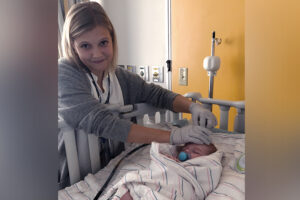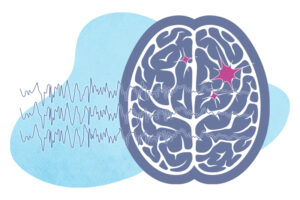Bedside tech predicts newborns’ outcomes after therapeutic hypothermia
Hypoxic-ischemic encephalopathy (HIE), brain injury caused by oxygen deprivation around birth, is a common cause of admission to the neonatal intensive care unit. Therapeutic hypothermia is now becoming the standard treatment to minimize brain injury; cooling the newborn’s head or whole body for three days slows cellular metabolism and allows brain cells to avoid and ... Read More about Bedside tech predicts newborns’ outcomes after therapeutic hypothermia
‘Life is so much better now’: Ethan finds treatment for mixed germ cell brain tumor
Ethan Winchenbach was playing with his dogs when he first noticed that something was off. “My vision changed, but only when I looked down,” he remembers. “It was really disorienting.” His mother, Becky, who is a nurse, knew immediately that something wasn’t right. When the symptoms didn’t improve, she made him an appointment with his ... Read More about ‘Life is so much better now’: Ethan finds treatment for mixed germ cell brain tumor
Could the right dietary fat help boost platelet counts?
Aside from transfusions, there currently is no way to boost people’s platelet counts, leaving them at risk for uncontrolled bleeding. Could something as simple as a dietary change raise platelet counts in people with low levels, such as cancer patients receiving chemotherapy? New science out of the lab suggests that the answer might be yes. ... Read More about Could the right dietary fat help boost platelet counts?
The key to preventing shin splints may be underfoot
Medial tibial stress syndrome, also known as shin splints, is a common and often recurring injury among adolescent runners. Recovery can involve weeks of downtime and sports modifications. Even then, many athletes experience chronic pain. Despite the prevalence and impact of the condition, sports medicine experts have yet to reach consensus about the cause. Theories ... Read More about The key to preventing shin splints may be underfoot
Nanobodies from alpacas could steer immune attacks on influenza
While conventional flu vaccines are designed to anticipate the influenza strains projected to dominate in the next flu season, they’re only partially effective. And while antiviral drugs are available to treat active flu cases, the body quickly clears them, requiring high, frequent doses. Coupling one existing flu drug with a special ingredient from alpacas, the ... Read More about Nanobodies from alpacas could steer immune attacks on influenza
Help your child prevent myopia with two simple steps
Myopia — also known as nearsightedness, or the inability to see things far away — is becoming more prevalent in children. Although myopia can be triggered by genetics, it can also develop because of environmental factors such as limited time spent outdoors and increased time indoors doing activities such as activities on electronics. Dr. Kimberley Chan, an optometrist ... Read More about Help your child prevent myopia with two simple steps
Emmie’s journey with type 1 diabetes and celiac disease
Emmie knows more about her own medical history than most children her age. Her journey to finding answers started when she was just 4 years old. She woke up one day looking “like I ate a bunch of blueberries or blackberries — my lips were turning blue,” explains Emmie, now 7. Her mom, Amanda, wasted ... Read More about Emmie’s journey with type 1 diabetes and celiac disease
DADA2: Working together to unpack a rare mystery illness
When Vanessa was a few months old, a mysterious red, bumpy rash appeared on her arms and legs. It would go away when she was sick with a virus, then come back. Although the rash disappeared for good just before she turned 2, Vanessa became anemic and increasingly fatigued. “She was fading away, losing weight, ... Read More about DADA2: Working together to unpack a rare mystery illness
Which children in status epilepticus are most at risk?
Status epilepticus, a prolonged, potentially life-threatening seizure, is epilepsy’s most severe manifestation. Patients known to have refractory status epilepticus are more likely to need ICU care if initial treatment is delayed. But what about the broader population of children who come to the emergency room in status epilepticus? Are there any early indicators to predict ... Read More about Which children in status epilepticus are most at risk?
Get a jump on potential eye conditions by having your child regularly tested
It can be surprising to learn your child has an eye condition. Children don’t always outwardly show symptoms of nearsightedness, a lazy eye, or another vision problem. That’s because children are adaptive. If one of their eyes doesn’t function well, they learn to adjust with the other one, according to Dr. Ryan Gise, an ophthalmologist in ... Read More about Get a jump on potential eye conditions by having your child regularly tested











